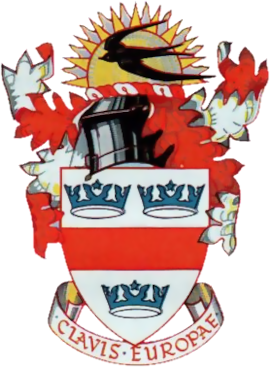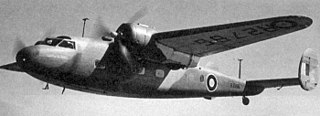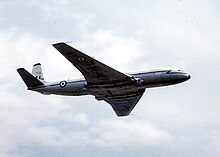
The de Havilland DH.106 Comet is the world's first commercial jet airliner. Developed and manufactured by de Havilland in the United Kingdom, the Comet 1 prototype first flew in 1949. It features an aerodynamically clean design with four de Havilland Ghost turbojet engines buried in the wing roots, a pressurised cabin, and large windows. For the era, it offered a relatively quiet, comfortable passenger cabin and was commercially promising at its debut in 1952.

Cyprus Airways (Public) Ltd. was the flag carrier airline of Cyprus. It was established in September 1947 and ceased operations on 9 January 2015. Cyprus Airways had its operating base at Larnaca International Airport.

British European Airways (BEA), formally British European Airways Corporation, was a British airline which existed from 1946 until 1974.

The Vickers VC10 is a mid-sized, narrow-body long-range British jet airliner designed and built by Vickers-Armstrongs (Aircraft) Ltd and first flown at Brooklands, Surrey, in 1962. The VC10 is often compared to the larger Soviet Ilyushin Il-62, the two types being the only airliners to use a rear-engined quad layout, while the smaller business jet Lockheed JetStar also has this engine arrangement.

The de Havilland DH.89 Dragon Rapide is a 1930s short-haul biplane airliner developed and produced by British aircraft company de Havilland. Capable of accommodating 6–8 passengers, it proved an economical and durable craft, despite its outdated plywood construction.

The de Havilland DH.95 Flamingo was a British twin-engined high-wing monoplane airliner first flown on 22 December 1938. During the Second World War some were used by the Royal Air Force (RAF) as a transport and general communications duties.

Dan-Air was an airline based in the United Kingdom and a wholly owned subsidiary of London-based shipbroking firm Davies and Newman. It was started in 1953 with a single aircraft. Initially, it operated cargo and passenger charter flights from Southend (1953–1955) and Blackbushe airports (1955–1960) using a variety of piston-engined aircraft before moving to a new base at Gatwick Airport in 1960, followed by expansion into inclusive tour (IT) charter flights and all-year round scheduled services. The introduction of two de Havilland Comet series 4 jet aircraft in 1966 made Dan-Air the second British independent airline after British United Airways to begin sustained jet operations.
Middle East Airlines – Air Liban S.A.L., more commonly known as Middle East Airlines (MEA), is the flag carrier of Lebanon, with its head office in Beirut, near Beirut–Rafic Hariri International Airport. It operates scheduled international flights to Asia, Europe, the Middle East, and Africa from its base at Rafic Hariri International Airport.
British Airtours was a charter airline in the United Kingdom with flight operations out of London Gatwick and Manchester Airports.

The de Havilland DH.91 Albatross was a four-engined British transport aircraft of the 1930s manufactured by de Havilland Aircraft Company Limited. Seven aircraft were built between 1938 and 1939.

South African Airways Flight 201 (SA201), a de Havilland Comet 1, took off at 18:32 UTC on 8 April 1954 from Ciampino Airport in Rome, Italy, en route to Cairo, Egypt, on the second stage of its flight from London, England to Johannesburg, South Africa. The flight crashed at around 19:07 UTC, killing all on board. The flight was operated as a charter by British Overseas Airways Corporation (BOAC) using the aircraft registration G-ALYY, with a South African crew of seven, and carrying fourteen passengers.
East African Airways Corporation, more commonly known as East African Airways, was an airline jointly run by Kenya, Tanzania, and Uganda. It was set up on 1 January 1946, starting operations the same year. The airline was headquartered in the Sadler House in Nairobi, Kenya. The corporation was dissolved in 1977 amid deteriorated relations among the three countries.

British Commonwealth Pacific Airlines or BCPA, was an airline registered in New South Wales, Australia in June 1946 with headquarters in Sydney. It was formed by the governments of Australia (50%), New Zealand (30%) and the United Kingdom (20%) to pursue trans-Pacific flights. BCPA was later taken over by Qantas.

British Eagle International Airlines was a major British independent airline that operated from 1948 until it went into liquidation in 1968. It operated scheduled and charter services on a domestic, international and transatlantic basis over the years.

The de Havilland DH.90 Dragonfly is a 1930s British twin-engined luxury touring biplane built by the de Havilland Aircraft Company at Hatfield Aerodrome.

The Hawker Siddeley HS-121 Trident is a British airliner produced by Hawker Siddeley. In 1957, de Havilland proposed its DH.121 trijet design to a British European Airways (BEA) request. By 1960, de Havilland had been acquired by Hawker Siddeley. The Trident's maiden flight happened on 9 January 1962, and it was introduced on 1 April 1964, two months after its main competitor, the Boeing 727. By the end of the programme in 1978, 117 Tridents had been produced. The Trident was withdrawn from service in 1995.

Channel Airways was a private airline formed in the United Kingdom in 1946 as East Anglian Flying Services.

Cambrian Airways was an airline based in the United Kingdom which ran operations from Cardiff Airport and Liverpool John Lennon Airport between 1935 and 1974. It was incorporated into British Airways when BOAC, BEA, Cambrian and Northeast merged on 1 April 1974.

Jersey Airlines was an early post-World War II private, independent British airline formed in 1948. In 1952, the airline operated its first scheduled service. Four years later, British European Airways (BEA) took a 25% minority stake in Jersey Airlines and made it an "associate". In June 1958, a Jersey Airlines de Havilland Heron became the first commercial airliner to arrive at the newly reconstructed Gatwick Airport. In 1960, Jersey Airlines ordered four state-of-the-art Handley Page Dart Herald 200 series turboprops. By 1962, BEA had sold its 25% minority holding in Jersey Airlines. The same year, Jersey Airlines became part of the British United Airways (BUA) group of companies. In August 1963, Jersey Airlines changed its trading name to British United (C.I.) Airways. Following the BUA group's 1967/8 reorganisation, BUA (C.I.) was absorbed into British United Island Airways (BUIA) in November 1968.

British Overseas Airways Corporation (BOAC) was the British state-owned airline created in 1939 by the merger of Imperial Airways and British Airways Ltd. It continued operating overseas services throughout World War II. After the passing of the Civil Aviation Act 1946, European and South American services passed to two further state-owned airlines, British European Airways (BEA) and British South American Airways (BSAA). BOAC absorbed BSAA in 1949, but BEA continued to operate British domestic and European routes for the next quarter century. The Civil Aviation Act 1971 merged BOAC and BEA, effective 31 March 1974, forming today's British Airways.





















